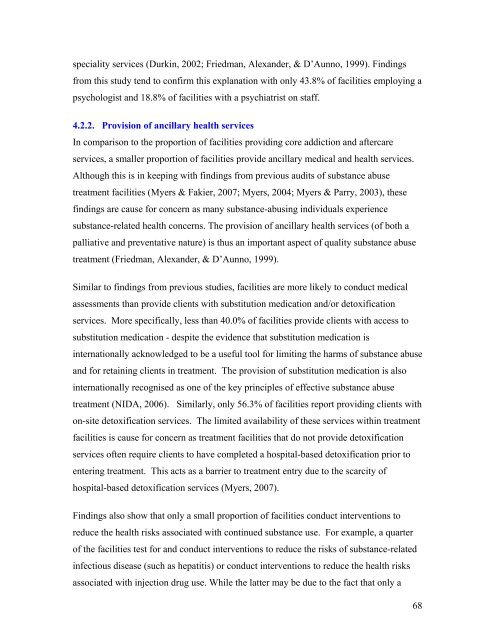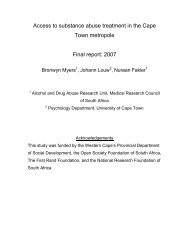Audit of Substance Abuse Treatment Facilities in ... - SA HealthInfo
Audit of Substance Abuse Treatment Facilities in ... - SA HealthInfo
Audit of Substance Abuse Treatment Facilities in ... - SA HealthInfo
- No tags were found...
Create successful ePaper yourself
Turn your PDF publications into a flip-book with our unique Google optimized e-Paper software.
speciality services (Durk<strong>in</strong>, 2002; Friedman, Alexander, & D’Aunno, 1999). F<strong>in</strong>d<strong>in</strong>gsfrom this study tend to confirm this explanation with only 43.8% <strong>of</strong> facilities employ<strong>in</strong>g apsychologist and 18.8% <strong>of</strong> facilities with a psychiatrist on staff.4.2.2. Provision <strong>of</strong> ancillary health servicesIn comparison to the proportion <strong>of</strong> facilities provid<strong>in</strong>g core addiction and aftercareservices, a smaller proportion <strong>of</strong> facilities provide ancillary medical and health services.Although this is <strong>in</strong> keep<strong>in</strong>g with f<strong>in</strong>d<strong>in</strong>gs from previous audits <strong>of</strong> substance abusetreatment facilities (Myers & Fakier, 2007; Myers, 2004; Myers & Parry, 2003), thesef<strong>in</strong>d<strong>in</strong>gs are cause for concern as many substance-abus<strong>in</strong>g <strong>in</strong>dividuals experiencesubstance-related health concerns. The provision <strong>of</strong> ancillary health services (<strong>of</strong> both apalliative and preventative nature) is thus an important aspect <strong>of</strong> quality substance abusetreatment (Friedman, Alexander, & D’Aunno, 1999).Similar to f<strong>in</strong>d<strong>in</strong>gs from previous studies, facilities are more likely to conduct medicalassessments than provide clients with substitution medication and/or detoxificationservices. More specifically, less than 40.0% <strong>of</strong> facilities provide clients with access tosubstitution medication - despite the evidence that substitution medication is<strong>in</strong>ternationally acknowledged to be a useful tool for limit<strong>in</strong>g the harms <strong>of</strong> substance abuseand for reta<strong>in</strong><strong>in</strong>g clients <strong>in</strong> treatment. The provision <strong>of</strong> substitution medication is also<strong>in</strong>ternationally recognised as one <strong>of</strong> the key pr<strong>in</strong>ciples <strong>of</strong> effective substance abusetreatment (NIDA, 2006). Similarly, only 56.3% <strong>of</strong> facilities report provid<strong>in</strong>g clients withon-site detoxification services. The limited availability <strong>of</strong> these services with<strong>in</strong> treatmentfacilities is cause for concern as treatment facilities that do not provide detoxificationservices <strong>of</strong>ten require clients to have completed a hospital-based detoxification prior toenter<strong>in</strong>g treatment. This acts as a barrier to treatment entry due to the scarcity <strong>of</strong>hospital-based detoxification services (Myers, 2007).F<strong>in</strong>d<strong>in</strong>gs also show that only a small proportion <strong>of</strong> facilities conduct <strong>in</strong>terventions toreduce the health risks associated with cont<strong>in</strong>ued substance use. For example, a quarter<strong>of</strong> the facilities test for and conduct <strong>in</strong>terventions to reduce the risks <strong>of</strong> substance-related<strong>in</strong>fectious disease (such as hepatitis) or conduct <strong>in</strong>terventions to reduce the health risksassociated with <strong>in</strong>jection drug use. While the latter may be due to the fact that only a68
















